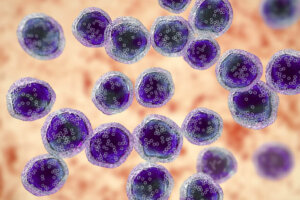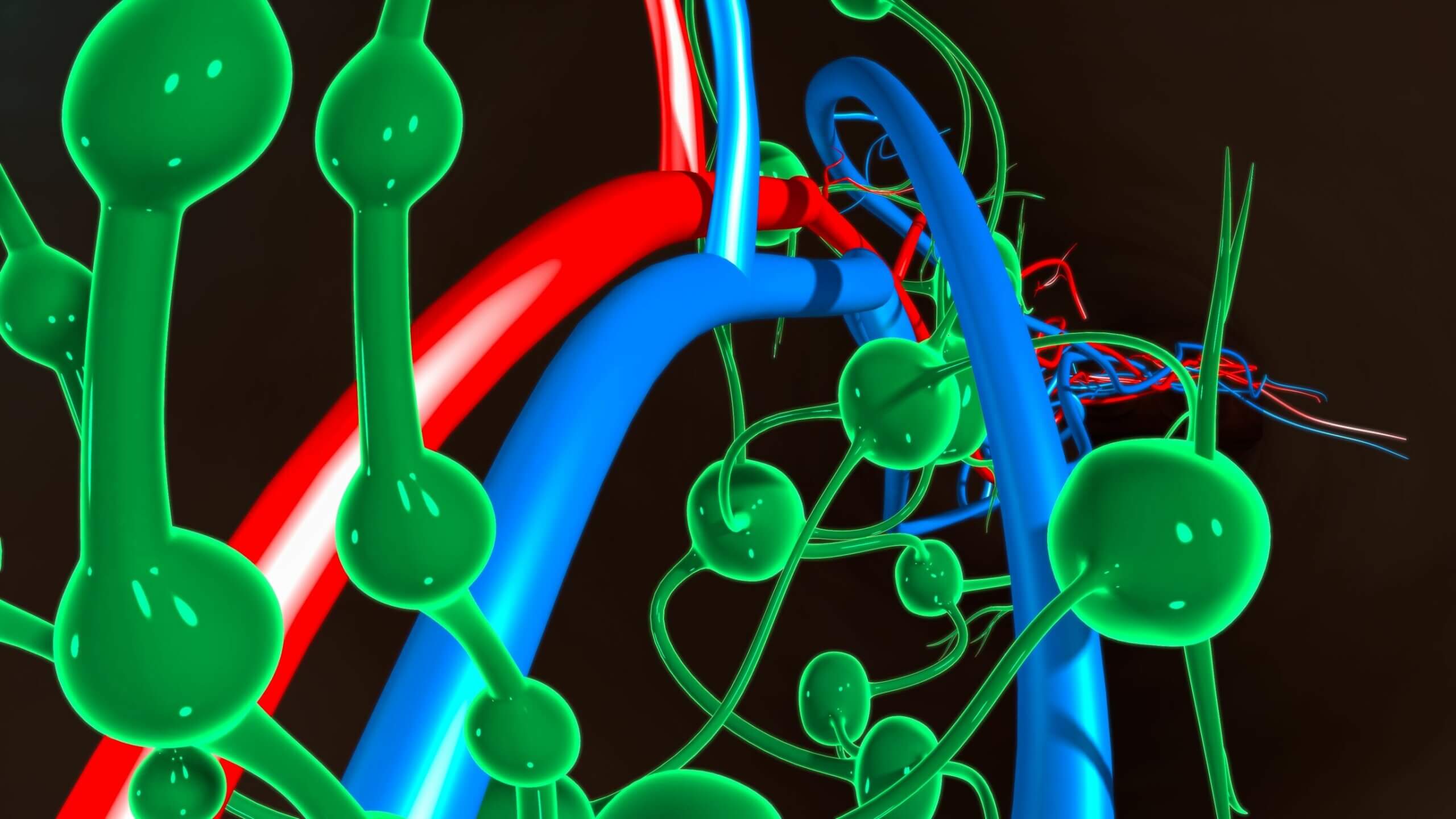What Is Hodgkin Lymphoma?

Oncological diseases can appear in any cell of the body, affecting various organs. When cancer cells affect the white blood cells of the lymphatic system, a pathology called lymphoma appears. Generally speaking, there are 2 different types of lymphomas, with Hodgkin’s lymphoma being the rarest of all.
Before talking about the pathology, it’s good to understand the lymphatic system. It’s made up of ducts that are distributed throughout the body, which contain a substance called lymph. Lymph contains multiple components, including specific white blood cells called B lymphocytes and T lymphocytes.
What is Hodgkin lymphoma?

Hodgkin lymphoma is nothing more than a cancer that begins in a maturing B lymphocyte, usually in a lymph node. Studies show that this pathology is more common in adolescents and young adults, although it can affect people of all ages.
Altered B lymphocytes lose their ability to create antibodies, so the body initiates various processes aimed at achieving cell death. However, these white blood cells have mechanisms that allow you to prevent their elimination. They also have the ability to initiate an uncontrolled duplication process, generating the appearance of the pathology.
This specific type of lymphoma most often appears in the lymph nodes in the neck, but can also be found in the chest, armpits, and groin. Rarely, the disease appears in other organs of the lymphatic system such as the spleen or thymus.
Types
The growth rate of a Hodgkin lymphoma and its treatment can vary depending on the histological findings of the neoplasm. In this sense, the World Health Organization (WHO) divided the pathology into two different groups, classic Hodgkin’s lymphoma and one with nodular lymphocyte predominance.
The classical presentation is characterized by the presence of Reed-Sternberg cells in the ganglia. These are giant B lymphocytes with several cell nuclei. In turn, this type of lymphoma is subdivided into 4 different groups, which have a very similar evolution and treatment. The 4 subgroups of classic Hodgkin lymphoma are as follows:
- Nodular sclerosis type
- Mixed cellularity type
- Rich in lymphocytes
- Lymphocytic depletion type
On the other hand, nodular lymphocytic predominant Hodgkin lymphoma has a specific type of malignant cells called popcorn cells. They’re a variant of Reed-Sternberg cells whose nucleus takes on an arrangement that resembles popcorn. Fortunately, it’s a mild lymphoma that responds well to traditional treatment.
Symptoms of Hodgkin lymphoma
The main clinical manifestation of this pathology is usually the enlargement of the affected lymph nodes. It’s characterized by being painless and appearing more frequently in the neck region. However, it’s important to note that any node in the body can be affected.
People can develop symptoms of different kinds, which are associated with compression of anatomical structures near the affected ganglion. In this sense, it’s possible to develop respiratory distress or coughing due to a massive growth of lymph nodes located in the mediastinum.
On the other hand, multiple studies show that the appearance of the so-called B symptoms is frequent when the lymph nodes acquire a considerable size and are in advanced stages. Symptoms B are a set of clinical manifestations related to malignant pathologies, being the following:
- Fever
- Shaking chills
- Night sweats
- Weight loss greater than 10% of body weight, not related to another more probable cause
Causes and risk factors
Currently, there’s no specific cause for Hodgkin lymphoma. Genetic alterations are believed to play a key role. In fact, a mutation in the 9p24.1 gene has been found in up to 100% of patients with the classic presentation.
On the other hand, infection with the Epstein-Barr virus, which causes mononucleosis, can increase the probability of developing this type of lymphoma. This virus has been observed in the Reed-Sternberg cells of many patients, so experts believe there’s some relationship.
The pathophysiological explanation isn’t entirely clear, but it’s believed that the virus can cause changes in the DNA of lymphocytes.
Another risk factor to consider is a family history of the disease. People with close family members diagnosed with Hodgkin lymphoma are more likely to have this condition. This could be due to the presence of a so far unidentified heritable gene.
People with a depressed immune system are also more likely to develop the condition. In fact, people infected with the human immunodeficiency virus (HIV) could develop the disease due to the constant use of antiretrovirals.
Diagnosis

The doctor will need to perform a physical examination of the various lymph nodes and confirm their enlargement. However, it’s necessary to rule out other possible causes of lymph node inflammation (such as infections) before giving an accurate diagnosis.
The specialist may also ask certain questions in order to identify the risk factors present for the development of the disease. The definitive diagnosis of Hodgkin lymphoma will be determined by a biopsy, as happens in other types of conditions such as breast cancer.
Lymph node biopsies are usually carried out only if the nodes don’t shrink on their own within a few weeks. Through the biopsy, the lymph of the ganglion and its contents will be studied in search of Reed-Sternberg cells or popcorn cells. Immunohistochemical tests can also be performed to identify altered proteins in cells.
Imaging tests can be helpful in looking for lymph node enlargement in difficult-to-explore regions such as the chest. They can also serve as a guide when taking samples for biopsy.
Blood tests aren’t usually of diagnostic value, but they can help determine how advanced the disease is.
Hodgkin lymphoma treatment
The main treatment options for treating Hodgkin lymphoma are chemotherapy and radiation therapy. Chemotherapy uses drugs to kill abnormal cells. For its part, radiotherapy uses high-energy rays to achieve the elimination of malignant cells.
Despite being the main treatment option, multiple studies establish that the form of application of these techniques will depend on the stage of the disease. In general terms, chemotherapy cycles are usually short and radiation therapy is directed to the affected fields in the early stages of the disease.
In contrast, chemotherapy cycles tend to be longer in the more advanced stages, and radiation therapy is not always helpful. People also often benefit from immunotherapy, which stimulates the immune system to kill cancer cells more efficiently.
The American Cancer Society states that stem cell transplantation can be helpful in cases where the lymphoma is difficult to treat. This technique will allow the application of higher doses of chemotherapy, avoiding damage to the bone marrow and more serious complications.
A rare disease with a good prognosis
Hodgkin lymphoma is a rare type of cancer that affects B lymphocytes and manifests as enlarged lymph nodes. Fortunately, the prognosis of people diagnosed with the disease is usually good, as long as there’s a timely diagnosis and treatment.
In this sense, it’s vitally important to seek medical help as soon as possible in the presence of an abnormal lump in any part of the body, especially if it isn’t painful.
Oncological diseases can appear in any cell of the body, affecting various organs. When cancer cells affect the white blood cells of the lymphatic system, a pathology called lymphoma appears. Generally speaking, there are 2 different types of lymphomas, with Hodgkin’s lymphoma being the rarest of all.
Before talking about the pathology, it’s good to understand the lymphatic system. It’s made up of ducts that are distributed throughout the body, which contain a substance called lymph. Lymph contains multiple components, including specific white blood cells called B lymphocytes and T lymphocytes.
What is Hodgkin lymphoma?

Hodgkin lymphoma is nothing more than a cancer that begins in a maturing B lymphocyte, usually in a lymph node. Studies show that this pathology is more common in adolescents and young adults, although it can affect people of all ages.
Altered B lymphocytes lose their ability to create antibodies, so the body initiates various processes aimed at achieving cell death. However, these white blood cells have mechanisms that allow you to prevent their elimination. They also have the ability to initiate an uncontrolled duplication process, generating the appearance of the pathology.
This specific type of lymphoma most often appears in the lymph nodes in the neck, but can also be found in the chest, armpits, and groin. Rarely, the disease appears in other organs of the lymphatic system such as the spleen or thymus.
Types
The growth rate of a Hodgkin lymphoma and its treatment can vary depending on the histological findings of the neoplasm. In this sense, the World Health Organization (WHO) divided the pathology into two different groups, classic Hodgkin’s lymphoma and one with nodular lymphocyte predominance.
The classical presentation is characterized by the presence of Reed-Sternberg cells in the ganglia. These are giant B lymphocytes with several cell nuclei. In turn, this type of lymphoma is subdivided into 4 different groups, which have a very similar evolution and treatment. The 4 subgroups of classic Hodgkin lymphoma are as follows:
- Nodular sclerosis type
- Mixed cellularity type
- Rich in lymphocytes
- Lymphocytic depletion type
On the other hand, nodular lymphocytic predominant Hodgkin lymphoma has a specific type of malignant cells called popcorn cells. They’re a variant of Reed-Sternberg cells whose nucleus takes on an arrangement that resembles popcorn. Fortunately, it’s a mild lymphoma that responds well to traditional treatment.
Symptoms of Hodgkin lymphoma
The main clinical manifestation of this pathology is usually the enlargement of the affected lymph nodes. It’s characterized by being painless and appearing more frequently in the neck region. However, it’s important to note that any node in the body can be affected.
People can develop symptoms of different kinds, which are associated with compression of anatomical structures near the affected ganglion. In this sense, it’s possible to develop respiratory distress or coughing due to a massive growth of lymph nodes located in the mediastinum.
On the other hand, multiple studies show that the appearance of the so-called B symptoms is frequent when the lymph nodes acquire a considerable size and are in advanced stages. Symptoms B are a set of clinical manifestations related to malignant pathologies, being the following:
- Fever
- Shaking chills
- Night sweats
- Weight loss greater than 10% of body weight, not related to another more probable cause
Causes and risk factors
Currently, there’s no specific cause for Hodgkin lymphoma. Genetic alterations are believed to play a key role. In fact, a mutation in the 9p24.1 gene has been found in up to 100% of patients with the classic presentation.
On the other hand, infection with the Epstein-Barr virus, which causes mononucleosis, can increase the probability of developing this type of lymphoma. This virus has been observed in the Reed-Sternberg cells of many patients, so experts believe there’s some relationship.
The pathophysiological explanation isn’t entirely clear, but it’s believed that the virus can cause changes in the DNA of lymphocytes.
Another risk factor to consider is a family history of the disease. People with close family members diagnosed with Hodgkin lymphoma are more likely to have this condition. This could be due to the presence of a so far unidentified heritable gene.
People with a depressed immune system are also more likely to develop the condition. In fact, people infected with the human immunodeficiency virus (HIV) could develop the disease due to the constant use of antiretrovirals.
Diagnosis

The doctor will need to perform a physical examination of the various lymph nodes and confirm their enlargement. However, it’s necessary to rule out other possible causes of lymph node inflammation (such as infections) before giving an accurate diagnosis.
The specialist may also ask certain questions in order to identify the risk factors present for the development of the disease. The definitive diagnosis of Hodgkin lymphoma will be determined by a biopsy, as happens in other types of conditions such as breast cancer.
Lymph node biopsies are usually carried out only if the nodes don’t shrink on their own within a few weeks. Through the biopsy, the lymph of the ganglion and its contents will be studied in search of Reed-Sternberg cells or popcorn cells. Immunohistochemical tests can also be performed to identify altered proteins in cells.
Imaging tests can be helpful in looking for lymph node enlargement in difficult-to-explore regions such as the chest. They can also serve as a guide when taking samples for biopsy.
Blood tests aren’t usually of diagnostic value, but they can help determine how advanced the disease is.
Hodgkin lymphoma treatment
The main treatment options for treating Hodgkin lymphoma are chemotherapy and radiation therapy. Chemotherapy uses drugs to kill abnormal cells. For its part, radiotherapy uses high-energy rays to achieve the elimination of malignant cells.
Despite being the main treatment option, multiple studies establish that the form of application of these techniques will depend on the stage of the disease. In general terms, chemotherapy cycles are usually short and radiation therapy is directed to the affected fields in the early stages of the disease.
In contrast, chemotherapy cycles tend to be longer in the more advanced stages, and radiation therapy is not always helpful. People also often benefit from immunotherapy, which stimulates the immune system to kill cancer cells more efficiently.
The American Cancer Society states that stem cell transplantation can be helpful in cases where the lymphoma is difficult to treat. This technique will allow the application of higher doses of chemotherapy, avoiding damage to the bone marrow and more serious complications.
A rare disease with a good prognosis
Hodgkin lymphoma is a rare type of cancer that affects B lymphocytes and manifests as enlarged lymph nodes. Fortunately, the prognosis of people diagnosed with the disease is usually good, as long as there’s a timely diagnosis and treatment.
In this sense, it’s vitally important to seek medical help as soon as possible in the presence of an abnormal lump in any part of the body, especially if it isn’t painful.
- Connors JM, Cozen W, Steidl C, Carbone A et al. Hodgkin lymphoma. Nat Rev Dis Primers. 2020;6(1):61.
- Shanbhag S, Ambinder R. Hodgkin lymphoma: A review and update on recent progress. CA: A Cancer Journal for Clinicians. 2017;68(2):116-132.
- Wang HW, Balakrishna JP, Pittaluga S, Jaffe ES. Diagnosis of Hodgkin lymphoma in the modern era. Br J Haematol. 2019;184(1):45-59.
- Mottok A, Steidl C. Biology of classical Hodgkin lymphoma: implications for prognosis and novel therapies. Blood. 2018;131(15):1654-1665.
- Townsend W, Linch D. Hodgkin’s lymphoma in adults. Lancet. 2012;380(9844):836-47.
- Pérez-Zúñiga JM, Aguilar-Andrade C, Álvarez-Vera JL, Augusto-Pacheco M y col. Linfoma de Hodgkin. Hematol Méx. 2019;20(2):124-130.
Este texto se ofrece únicamente con propósitos informativos y no reemplaza la consulta con un profesional. Ante dudas, consulta a tu especialista.







